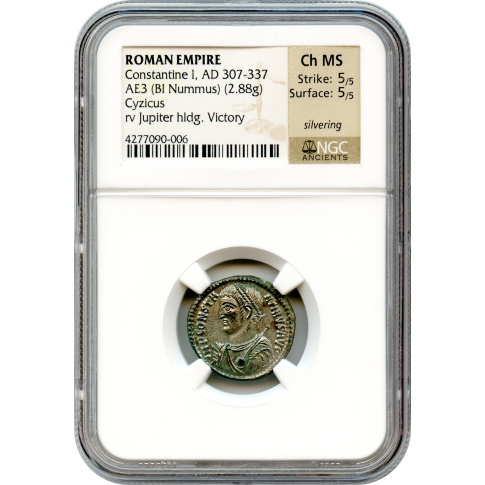Ancient Rome - AD 307-337 Constantine I AE3 (BI Nummus) NGC Choice MS Ex.Robbins Collection
Constantine I 'the Great' BI Nummus. Cyzicus Mint, AD 317-320. NGC Choice MS. Strike: 5/5, Surface: 5/5. 2.88 g. Obverse legend: IMP CONSTANTINVS AVG, laureate and draped bust of Constantine I to the left, holding orb and mappa in his right hand, and sceptre in left. Reverse legend: IOVI CONSERVATORI AVGG, Jupiter standing to left, leaning on sceptre and holding Victory on globe; wreath in left field, E in right field, SMK in exergue. RIC VII 8.

Head of the Colossus of Constantine at the Capitoline Museum. Photo: Wikimedia Commons.
Constantine I 'The Great' (Flavius Valerius Constantininus), c. A.D. 272/4-337, was Augustus from A.D. 307-337. His importance to western history cannot be underestimated. He is connected to the emergence of Christianity as the major religion of the Western world, thereby bringing Europe into the post-classical world. Constantine was son of Constantius I, a Danubian soldier whose origins were humble. Nonetheless, despite his humble ancestry, he achieved the ranks of both Caesar and Augustus. All accounts tell us that Constantine was violent, suspicious, temperamental, and intimidating. The historian Eusebius writes that as a young man he was tall, graceful, and so thoroughly surpassed "his contemporaries in personal strength that he struck terror into them." His behavior was opportunistic and inconsistent; he only followed policies that served his immediate needs. His adoption of Christianity did not include following the teachings of that religion. Constantine was an enigma. He was concurrently a self-assured emissary of God and a completely ruthless murderer and single-minded aggressor who would go to any lengths to be the sole emperor.
A brilliant general, administrator, and statesman, he not only led Europe from paganism to Christianity, but he also started the construction of Constantinople, which ranks among the greatest achievements of late antiquity. In 306 Constantine and his father sailed to Britain, where they shared command in the war against the Picts. During the early part of his reign, he remained in the West, devoting his efforts to defending the Rhine. From 306 to 307 he waged war upon the Franks. He did not leave Gaul until 312. Different alliances and conflicts arose between Constantine and Maxentius, Maximian, Severus II, Galerius, Lincinius I and Maximinus Daia. By 313, all were dead except for Constantine and Licinius I, who together ruled the empire, linked by a dynastic marriage and a political alliance. However, the two men distrusted each other, each of them desiring supreme power over Rome. Treachery on the part of Licinius I resulted in the First Licinian War in 316. Constantine won, and the peace saw Licinius lose much of his European territory. A few years later, Constantine marched into Thrace, which was Licinius' territory. That led to the Second Licinian War of 324. The aftermath of that war saw Licinius executed. Constantine now realized his long term goal of ruling Rome alone. He then began the projects that would shape his legacy and the future of the western world. The building of Constantinople was chief among them. He also constructed many religious and secular buildings throughout the empire. He also worked tirelessly to unite the different factions of the Christian church. He died on May 22, 337.
| Grading Service | NGC |
|---|---|
| Year of Issue | NONE |
| Grade | MS63 |
| Ancient Year Range | 301-400 AD |
| Denom Type | Ancient |
| Numeric Denomination | AE3 (BI Nummus) |
| Mint Location | NONE |
| Designation | NONE |
| Circ/UnCirc | Uncirculated |
| Strike Type | Business |
| Holder Variety | Strike 5/5; Surface 5/5 - plenty of original silvering remaining on surfaces! |
| Grade Add On | NONE |
| Holder Type | N/A |



